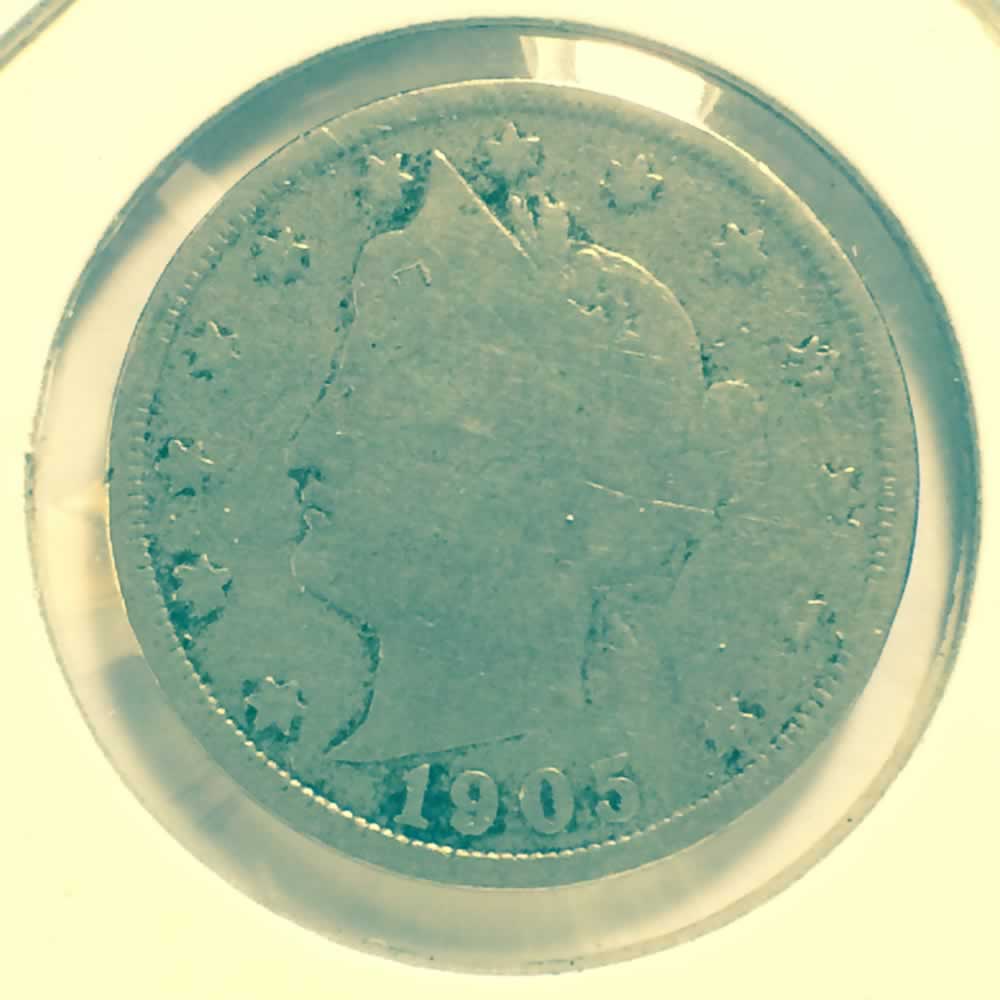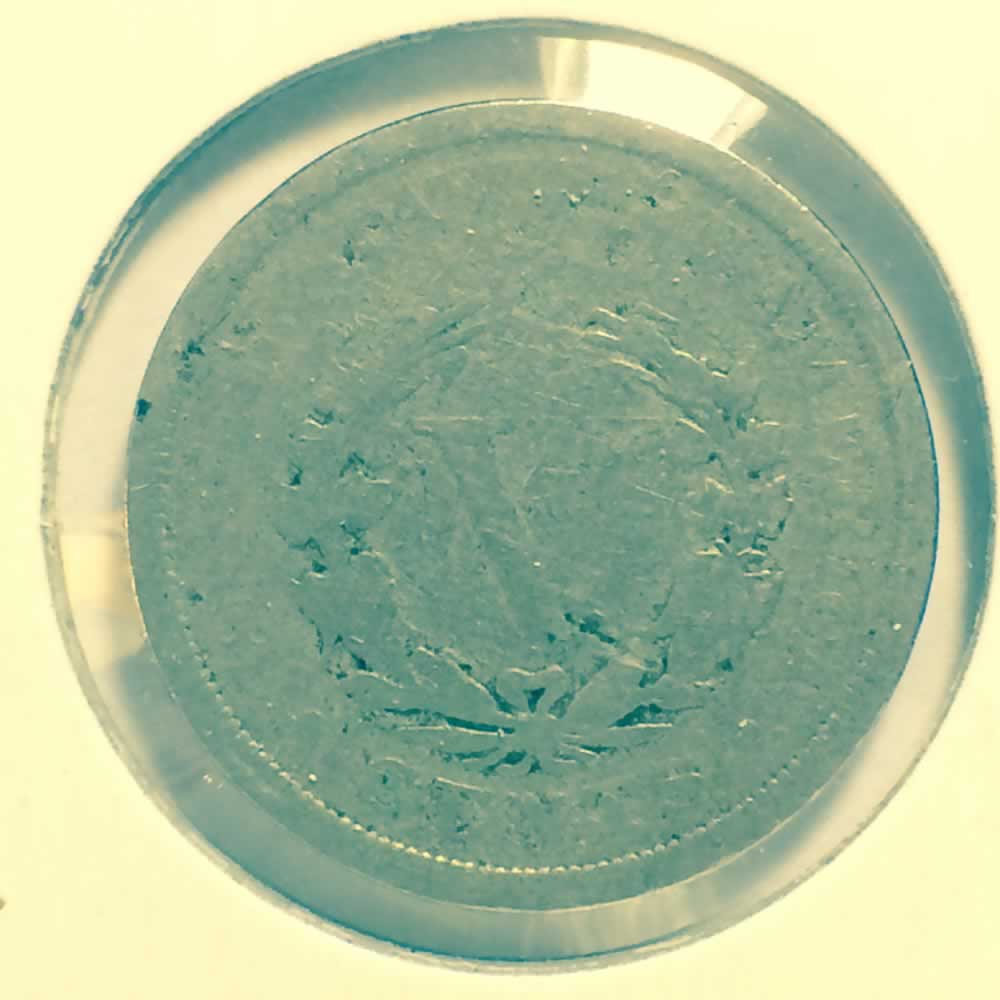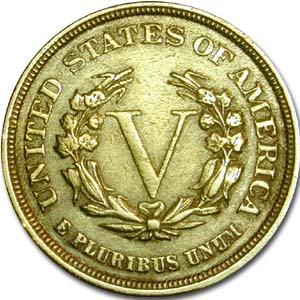The Liberty Head nickel, sometimes referred to as the V nickel because of its reverse (or tails) design, is an American five-cent piece. It was struck for circulation from 1883 until 1912, with at least five pieces being surreptitiously struck dated 1913.
The original copper–nickel five-cent piece, the Shield nickel, had longstanding production problems, and in the early 1880s, the United States Mint was looking to replace it. Mint Chief Engraver Charles Barber was instructed to prepare designs for proposed one-, three-, and five-cent pieces, which were to bear similar designs. Only the new five-cent piece was approved, and went into production in 1883. For almost thirty years large quantities of coin of this design were produced to meet commercial demand, especially as coin-operated machines became increasingly popular.
Beginning in 1911, the Mint began work to replace the Liberty head design, and a new design, which became known as the Buffalo nickel, went into production in February 1913. Although no 1913 Liberty head nickels were officially struck, five are known to exist. While it is uncertain how these pieces originated, they have come to be among the most expensive coins in the world, with one selling in 2010 for $3,737,500.
History courtesy of Liberty Coin Collector Society
**
Chester Alan Arthur was in the White House, and Franklin Delano Roosevelt was napping in a nursery in Hyde Park, New York. FDR, after all, was only one year old at the time. Horse-drawn carriages ruled the roads and in New York City, they also reigned supreme on the just-completed Brooklyn Bridge.
The year was 1883, and one year after FDR's arrival in that nursery, the United States Mint was busy giving birth to a "baby" of its own: the Liberty Head five-cent piece.
The father of the new coin was A. Loudon Snowden, Superintendent of the Philadelphia Mint. Snowden believed that the nation's three minor coins, the cent, three-cent piece and five-cent piece, should be uniform in design and metallic composition. In 1881 he directed Chief Engraver Charles E. Barber to prepare suitable sketches for these denominations, with all three to feature a classical head of Liberty.
Barber completed the task late that year, and trial strikes were made of the three coins. All were very simple in design, with the Liberty head on the obverse and a Roman numeralI, III or Von the reverse within a wreath, signifying values of one, three and five cents, respectively. All were struck in copper-nickel, the same alloy being used already in the three-cent piece and the Shield nickel.
It soon became apparent that Congress would oppose a change in composition for the cent, which was made of bronze. Furthermore, the Treasury would not permit a design change for the three-cent piece. That left only the five-cent piece, and Snowden and Barber concentrated on overhauling it.
The Shield nickel, introduced in 1866, was the first base-metal five-cent piece in U.S. history; up to then, the half dime, a small silver coin, had filled the nation's need for that denomination. Though reasonably well accepted, the Shield nickel was hardly untouchable; its stark, bland design made it a prime candidate for remodeling. And its newness didn't protect it from replacement: At that time, there wasn't yet a federal law establishing a minimum life expectancy for U.S. coin designs.
Snowden admired Barber's new design, and he also welcomed the change because it gave him a chance to increase the diameter (and thus reduce the thickness) of the nickel. He believed that this would lengthen die life dramatically. Snowden proudly unveiled the Liberty Head nickel at a special ceremony on Jan. 30, 1883. Dignitaries attended and souvenirs of the first strikes were distributed to the guests. Regular coinage began later that weekthen suddenly, the celebrating stopped.
The first "V nickels" had barely left the Mint when appalled officials found a fundamental flaw in their design: Barber had omitted the word CENTS. His oversight soon created a crisis for Uncle Sam: Confidence artists were plating the nickels with gold and passing them off to unsuspecting merchants as $5 gold pieces. They were, after all, virtually the same size as half eagles. As brand new coins, they were still unfamiliar to the public, and they lacked any statement of value beyond the letter V, which, of course, could represent either five cents or five dollars.
Barber quickly prepared a new design, this time placing CENTS in big, bold letters below the V. By then, however, the Mint had struck nearly 5 1/2 million of the so-called "Type 1" nickels, and many had been gold-plated and passed. Even today, it isn't uncommon to find these "racketeer nickels" in hoards and collections. Their value as collector's items is small, but they hold great appeal as historical curiosities. By the end of 1883, the Mint had produced more than 16 million nickels with CENTS on the reverse, but the "no CENTS" variety is far more common today in choice condition. Many people set examples aside, mistakenly believing that having been replaced, these would someday be rare.
Following all the drama surrounding its introduction, the Liberty Head nickel settled down to a sedate existence and one more befitting its role as a coin of the realm in the late Victorian era. There were no further changes in its simple, straightforward design, and for all but the final year, there were no branch-mint issues to complicate matters, either; the Philadelphia Mint produced the entire mintage except in 1912, when Denver and San Francisco struck the coin as well in its last official appearance. (The mint mark appears to the left of the word CENTS on the reverse).
There are low-mintage issuesnotably 1885, 1886 and 1912-Sbut there are no great rarities; 1912-S, at 238,000, is the only coin with a mintage below a million. At the other extreme, not one V nickel topped the 40-million mark; 1911 is the highest with just over 39.5 million.
In 1913, the Liberty Head design gave way to the Buffalo type. No Liberty nickels were made that year officially, but years later collectors were stunned to learn that five 1913 examples had surfaced, all of them apparently made on the sly by someone at the Philadelphia Mint. Despite their clouded origins, these came to be accepted as legitimate collectibles, and they now rank among the most coveted and valuable of all U.S. coins.
Although it covers 30 years, the Liberty nickel series makes for a compact and completeable set, largely because of the all-but-total lack of branch-mint issues. For that reason, it's widely collected by date and mint, though many do collect it simply by type. Proofs were made in every year, always in the thousands, a high level for that period.
Because of their low relief, V nickels are generally well struck and are readily available in very high grades. Points to check for wear are the hair above Liberty's ear and the wreath and corn ears on the reverse.
Controversy marked both the birth and the demise of the Liberty Head nickel. There's no disputing one thing, though: This is a coin with exceptional appeal for collectors.
**
REF: Wiki 'no marks'
REF**: Liberty Head Nickel Collector Society
NOTE:
If your looking for more information
Liberty Head Nickel Collector Society
has a great collection of data.
**
Some of this historical information is provided complements of NGC (Numismatic Guarantee Corporation). NGC is the "grading service of choice" of the ANA (American Numismatic Association), the largest collector oriented organization in the United States. NGC is one of the two largest independent grading services. NGC has been grading coins since 1987, and have graded in excess of two and one half million coins.
Year & Mint Mintage Proof Mintage
1883 No CENTS 5,474,300 5,219
1883 With CENTS 16,026,200 6,783
Year Mintage Proof Mintage
1884 11,270,000 * 3,942
1885 1,473,300 * 3,790
1886 3,326,000 * 4,290
1887 15,260,692 * 2,960
1888 10,715,901 * 4,582
1889 15,878,025 * 3,336
1890 16,256,532 * 2,740
1891 16,832,000 * 2,350
1892 11,696,897 * 2,745
1893 13,368,000 * 2,195
1894 5,410,500 * 2,632
1895 9,977,822 * 2,062
1896 8,841,048 * 1,862
1897 20,426,797 * 1,938
1898 12,530,292 * 1,795
1899 26,027,000 * 2,031
1900 27,253,733 * 2,262
1901 26,478,228 * 1,985
1902 31,487,581 * 2,018
1903 28,004,930 * 1,790
1904 21,403,167 * 1,817
1905 29,825,124 * 2,152
1906 38,612,000 * 1,725
1907 39,213,325 * 1,475
1908 22,684,557 * 1,620
1909 11,585,763 * 4,763
1910 30,166,948 * 2,405
1911 39,557,639 * 1,733
1912 26,234,569 * 2,145
1912-D 8,474,000 * 0
1912-S 238,000 * 0
1913 0 * 5 known
 US 1905 Liberty Head 'V' Nickel ( 5C )
US 1905 Liberty Head 'V' Nickel ( 5C )



